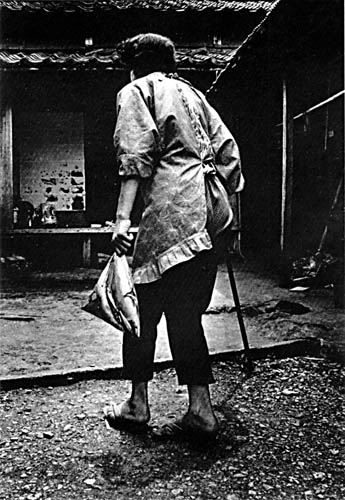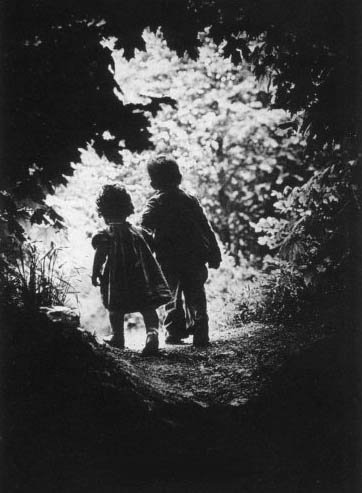W. Eugene Smith
"Subject Knowledge" is the most important camera skill.
- He is a local (really regional) boy who had world-wide influence and we should know about him
- Although he wasn't shooting dance he immersed himself with his subjects, what any dance photographer should do.
- He combined art and journalism (information)
In days past magazines would give photographers months, or more, to spend time with someone in order to produce a photo essay. A photo essay has both words and pictures, but depends on pictures to really tell the story. W. Eugene Smith spent more than that on his own. Smith was one of the people who formed the entire concept of photography as journalism and the photo essay , leaving his native Wichita, Kansas in the mid 1930's to work with Time and later LIFE and later on his own for anyone, sometimes living between pawned cameras. His pictures combine achingly beautiful art with intimate knowlege. They set standards we are still trying to live up to today. Something which is hard to do if you merely drop by to shoot without spending the kind of time he spent.
(Another world-famous "local" was Gordon Parks from Winfield, KS. Parks recently died.)
W. Eugene Smith was fired in 1938 by Newsweek because he used a "miniature" camera. At that time the standard regular-size camera used a 4-inch by 5-inch (4x5) negative. Anything smaller (i.e. 35mm) was called a miniature camera. Smaller than 35mm was subminiature, such as a Minox. Today we consider 4x5 the smallest of "large format" sizes. Back then a 2-1/4x2-1/4 camera such as a twin-lens reflex was the largest of the miniature formats. Today this is called medium format and 35mm is considered standard.
While Smith used all these formats he mostly used 35mm. From the accounts I've read I remain unclear whether the "miniature" camera he insisted on using, despite Newsweek's published policy, was a 2-14-square twin lens reflexe (TLR) or a 35mm camera. Most articles seem to assume that miniature meant 35mm. But he was also using TLRs at the time.
In any case it was assumed by many (in this case Newsweek) that good pictures could not be taken with smaller than 4x5 formats. Good pictures required the technical smooth tonal scales and detail in a 4x5 negative - supposedly. Whoever fired Smith was stupid (though Smith could be difficult to work with). But Smith had a life-long dislike of the emotional suffering newspapers had put his family through in covering his father's suicide. As a result, he almost didn't become a photo journalist.
W. Eugene Smith went to World War II in the Pacific photographing for LIFE until badly wounded. After recovery he had a tumultuous time with LIFE magazine, finally leaving it and still later, living in Minimata Japan with his Japanese wife, he spent years of his life documenting the people's fight against mercury poisoning. As far as I know he never shot dancers but the lessons of how he shot pictures by knowing the people and spending time with those he photographed, often across years, apply to dance as much as anything. In the pictures below you can sense his closeness to his subjects.
|
 Saipan -1944 - a wounded infant found by an American soldier on Saipan, World War II |
 Dr Albert Sweitzer - 1954 - photo essay on Dr. Albert Schweitzer and his humanitarian work in French Equatorial Africa |
From: "Maude Callen was born in Quincy, Florida, in 1898. She was educated at Florida A & M and took a nursing course before moving to Berkeley County as a nurse and midwife in 1923. Sponsored by the Episcopal Church, Callen spent 13 years as a nurse and midwife in the Pineville area before joining the Berkeley County Health Department. Her work, which included the training of hundreds of midwifes, took her to all parts of Berkeley County. "In 1951, Life magazine published a twelve-page photographic profile of Callen's work, which generated some $27,000 in contributions used to construct a modern clinic in Pineville. Callen continued work at this clinic until her retirement in 1971. "Callen was named Outstanding Older South Carolinian in 1981 by the South Carolina Commission on Aging, and was presented the Order of the Palmetto by Governor Richard W. Riley. "She was also presented the Alexis de Tocqueville Society Award in 1984 for sixty years of service to her community and was featured in a 1983 segment of “On the Road with Charles Kuralt.” "Honored many times in Berkeley County, Callen continued to volunteer as manager of the Senior Citizens Nutrition Council in Pineville and personally delivered meals on wheels five days a week until her death in 1990." |
 Spanish Village - mourners just outside a deathbed room - 1950 - photo essay on the small Spanish town of Deleitosa |
A posting on the Web by Dr. Ernest Ceriani’s son Gary, a lawyer in Denver. "Ernest Ceriani was my father so I can probably answer just about whatever questions you have. Dad continued to practice in Kremmling until the mid 1980's (he was on his third generation of deliveries when he finally retired). Not long after he retired he was diagnosed with multiple myeloma and he died on April 28, 1988 at a hospice in Denver having made the decision, while still intellectually capable, that he was deteriorating rapidly and wanted to stop dialysis and end his life with dignity and peace. My mother died on November 12, 1991 of a stroke. My brother Phil was an orthopedic surgeon until he retired. He now lives in Paonia, Colorado. I am an attorney in Denver and live in Golden with my wife of 35 years." |
Wikipedia Entry: http://en.wikipedia.org/wiki/W._Eugene_Smith
Brief Bio: http://www.photo-seminars.com/Fame/eugesmith.htm
Smith Fund: http://www.smithfund.org/fund.html
Smith said of himself, "I am an idealist. I often feel I would like to be an artist in an ivory tower. Yet it is imperative that I speak to people, so I must desert that ivory tower. To do this, I am a journalist—a photojournalist. But I am always torn between the attitude of the journalist, who is a recorder of facts, and the artist, who is often necessarily at odds with the facts. My principle concern is for honesty, above all honesty with myself..."
Quote from the PBS page on Smith: http://www.pbs.org/wnet/americanmasters/database/smith_w.html
"When W. Eugene Smith died in Tucson, Arizona in 1978, he left behind a legacy of some of the most powerful photographs in the history of journalism. His personal approach to integrating his life into the lives of his subjects revolutionized the somewhat new form of photojournalism known as the photo essay. His body of work remains one of the primary bridges between photojournalists and fine art photographers. In the end W. Eugene Smith's greatest gift was his life long insistence that journalistic photography always search for the depth and humanity of its subjects."
 Spanish Village - 1950 |
 Yae Sato With Fish And Cane, Minamata, Japan, 1972 |
 The Walk |
 Steel Worker, Pittsburgh, PA |


